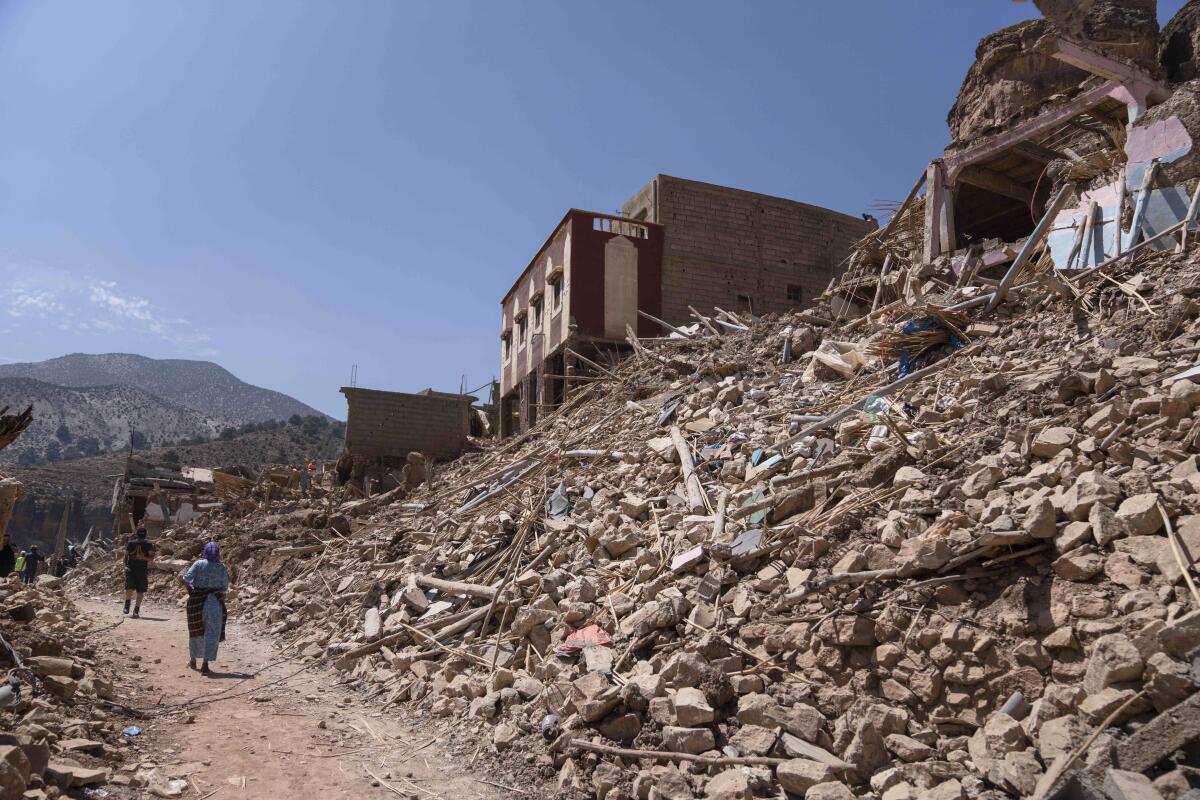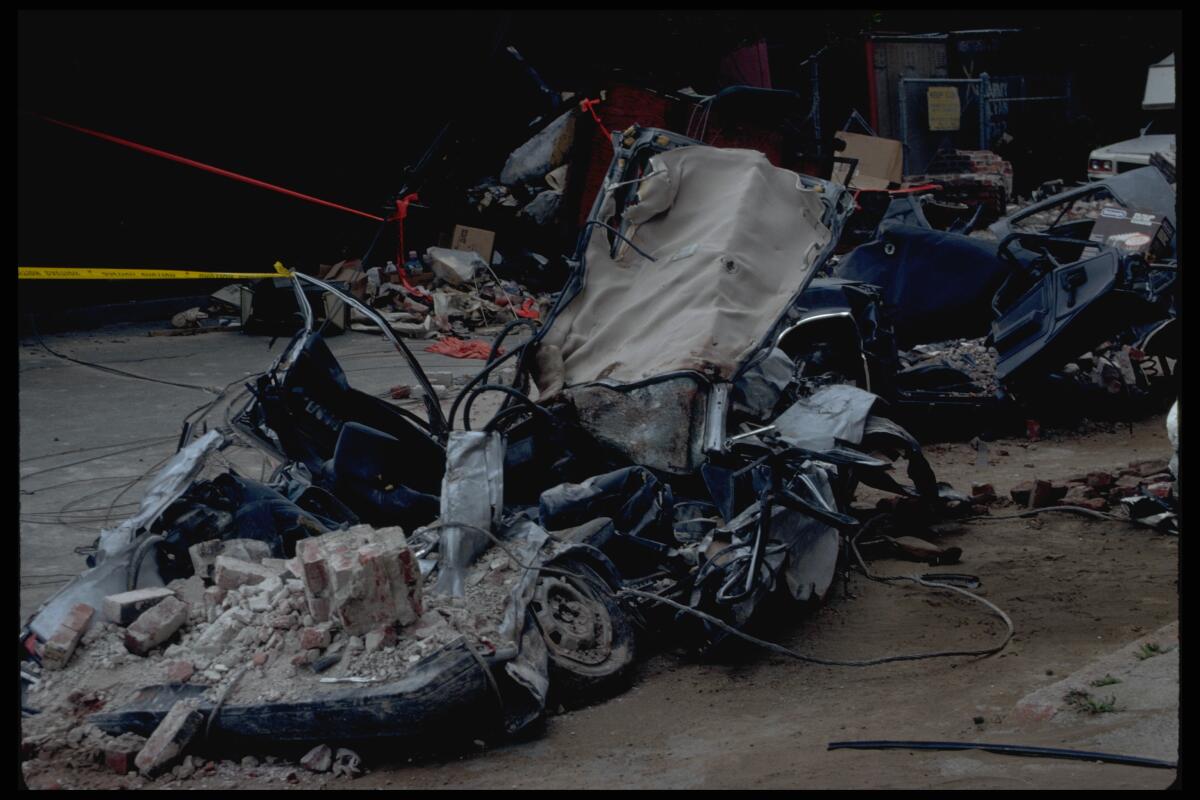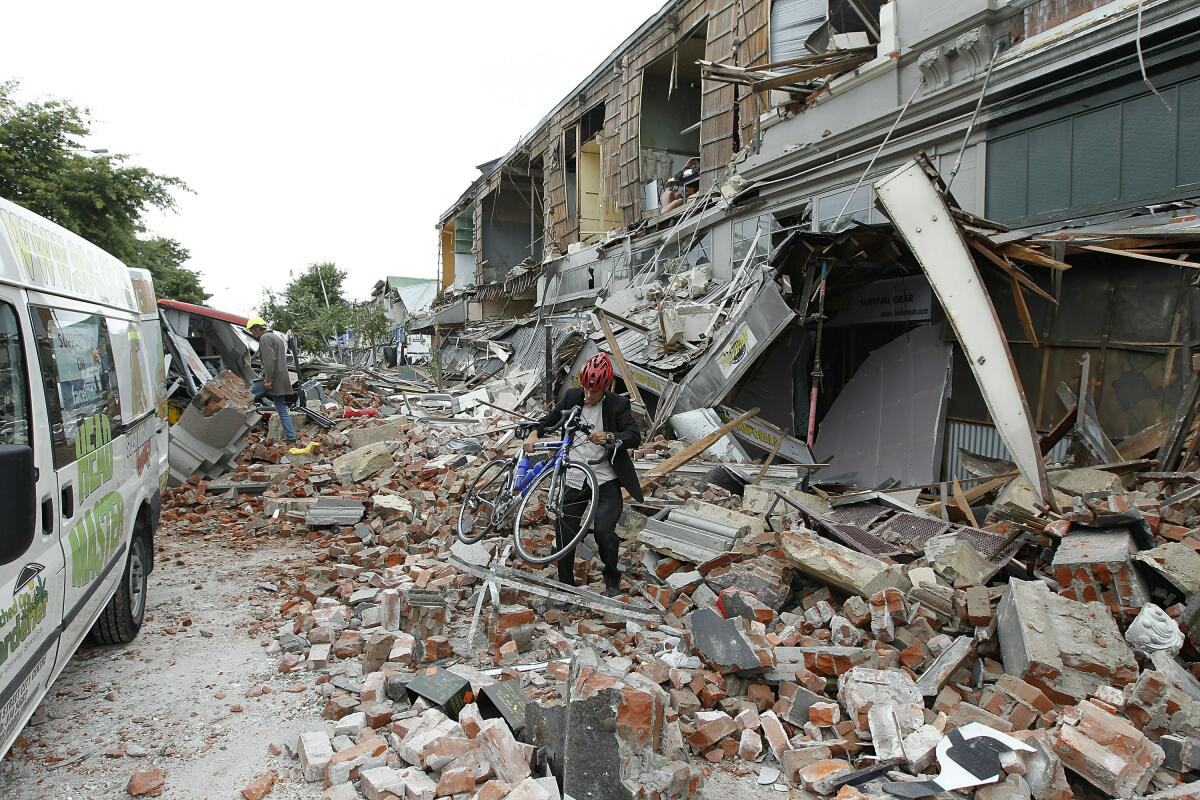Morocco earthquake is a warning for California: Weak brick buildings can become deathtraps

- Share via
The scenes of devastation from the Morocco earthquake are both horrifying and grimly familiar.
Piles of mud bricks littering whole neighborhoods where homes and businesses once stood. Rescuers walking over mounds of debris so massive they obscure the landscape. Residents so fearful of more buildings falling that they’re sleeping on the street.
The hard-hit ancient city of Marrakech, founded a millennium ago, might seem half a world away from California.
But the destruction wrought by weak brick structures breaking apart, unable to withstand seismic activity, is something with which California must also grapple.
The 1925 Santa Barbara and 1933 Long Beach earthquakes offered early warnings that unreinforced masonry buildings could become deathtraps in a major quake. New construction of such buildings was banned in the 1930s, and more losses from those still standing during the 1971 Sylmar quake prompted a major push to either demolish or make such older buildings safer.
But while many cities in California have taken such action, some others have not — inaction that could dramatically increase the death toll in a future earthquake.

California learned the dangers of brick construction when a major earthquake struck Long Beach in 1933.
At their core, the old mud brick-style of construction in Morocco and the masonry buildings in California of the 19th and early 20th centuries have essentially similar flaws: They’re brittle and when shaken in an earthquake, they can collapse in a heap.
Morocco’s destruction is “very similar to what can happen with brick buildings in California,” said Craig Chamberlain, president of the Structural Engineers Assn. of Southern California.
The buildings in Morocco that were destroyed in Friday night’s quake were mostly unreinforced masonry adobe or brick buildings that are very prone to collapsing when shaken. More than 2,800 people were killed, many crushed under the heavy bricks or buried in the rubble.
Some older brick buildings in California can be dangerous because they don’t have a lot of ductility — the ability of a material to have its shape changed without breaking, said Patti Harburg-Petrich, a past president of the Structural Engineers Assn. of Southern California.
“Your car has a bumper so that if you hit something, that bumper absorbs the energy, so that your body and the occupants in the car are protected from the force of that collision,” she said. Modern buildings are designed with a similar idea: “Buildings are designed with ductility to absorb that energy from the earthquake to keep people safe, so that they can safely exit the building.”
But older brick buildings “don’t necessarily have a lot of ductility because they’re constructed from brittle materials,” she added, and lack reinforcement like steel that can help provide that flexibility.

During an earthquake, the mortar binding bricks together essentially dissolves, causing the walls to collapse and then the roof, said seismologist Lucy Jones.
“You can still kill people with collapsing masonry. But you’ll kill more if the roof comes down too,” Jones said.
Even in more recent earthquakes in California, brick walls have continued to come crashing down onto building occupants, as well as people on sidewalks and motorists on the street, coming with so much force that commuters can be killed in their cars.
In 2003, two women who worked at a dress shop in Paso Robles died after a magnitude 6.5 earthquake on California’s Central Coast brought down their building, a historic structure built in the 1890s that city officials already warned was potentially hazardous in an earthquake.

The 1989 Loma Prieta earthquake brought down a San Francisco brick building’s fourth-story wall onto a parking lot below, leaving cars smashed and killing five people. And in the 2014 magnitude 6 Napa earthquake, bricks came raining down on sidewalks in the city’s downtown, which could have been deadly projectiles had the earthquake struck during daylight hours.
And in New Zealand, which suffered a devastating earthquake in the city of Christchurch in 2011, there were dozens of deaths resulting from the collapse of a wall or a facade of an old brick building. Four died inside a older brick building, three died while running out of a building to escape, and 26 died as a result of a brick wall or facade collapsing on pedestrians or on top of vehicles.
On one Christchurch street, eight people died after huge chunks of unretrofitted brick buildings collapsed onto a bus, killing the driver and all but one passenger. Four pedestrians nearby also died.
If “you’re walking on the street, that brick wall will come right on top of you. And you have instantaneous death,” said structural engineer Kit Miyamoto, CEO of Miyamoto International, of unretrofitted older brick buildings. “That’s a huge, huge risk.”
While many California cities have taken action on old brick buildings — the city of Los Angeles in 1981 decreed that they be strengthened or demolished — there are a number of notable cities that have taken little action.

A Times analysis of building and safety records in 2018 found that as many as 640 buildings in more than a dozen Inland Empire cities, including Riverside and San Bernardino, have been marked as dangerous — but remained unretrofitted despite decades of warnings.
The region is particularly at risk of a major earthquake — three of the state’s most dangerous faults, the San Andreas, the San Jacinto and the Cucamonga, intersect in this region east of Los Angeles. But most local cities have not been able to require these vulnerable buildings to be retrofitted or torn down.
Cities elsewhere have vulnerable buildings too. For decades, a law in Ventura mandated that brick buildings be retrofitted above the roof line — strengthening only the parapet, a low wall on the roof — a minimal requirement that does not fix the vulnerability that puts the rest of the structure at risk of collapse. There was interest in 2018 about pursuing options that could require full retrofits of brick buildings, but by 2019, progress on figuring out a solution appeared to have stalled.
The U.S. Geological Survey has classified old brick buildings as one of just two building types that “pose the greatest risk to life safety.” The other type is non-ductile concrete, which lacks an adequate configuration of reinforcing steel within the concrete frame of the building. When shaken, concrete can explode out of a column, leading to a catastrophic collapse. Non-ductile concrete buildings can be much larger than brick buildings, and caused many of the more than 50,000 deaths when earthquakes hit southern Turkey and northern Syria earlier this year.
Owners of vulnerable, older brick buildings risk significant lawsuits should they do nothing about their building risk, experts say, even if a local government has not yet ordered them to complete an earthquake retrofit, or if a deadline to do so has not yet passed.
The families of the two women who died in Paso Robles in 2003 were awarded nearly $2 million by a jury, which found that the property owners were negligent for not making the building safer. Even though a city deadline to complete the retrofit was still years away when the earthquake hit, the jury found the owners bore financial responsibility for not retrofitting their building sooner.
In 2010 a state appeals court upheld the verdict, finding that the building’s compliance with city law “did not insulate owners of [the] unreinforced building from negligence in failing to retrofit.”
More to Read
Sign up for Essential California
The most important California stories and recommendations in your inbox every morning.
You may occasionally receive promotional content from the Los Angeles Times.















